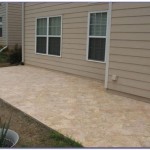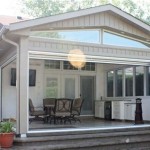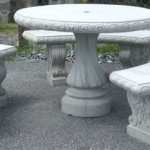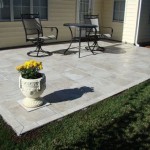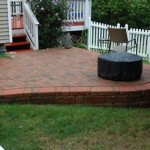Fixing a Concrete Patio: A Comprehensive Guide
A concrete patio offers a durable and versatile outdoor space for relaxation, entertainment, and various leisure activities. However, over time, exposure to the elements, heavy use, and underlying soil movement can lead to cracks, spalling, and other forms of degradation. Addressing these issues promptly is crucial not only for aesthetic reasons but also to prevent further damage and maintain the structural integrity of the patio. This article provides a detailed guide to diagnosing, repairing, and protecting a concrete patio, ensuring its longevity and enhancing its usability.
Before embarking on any repair project, a thorough assessment of the patio's condition is essential. This involves identifying the type and severity of the damage, as well as understanding the potential causes. Common problems include cracking, surface scaling or spalling, staining, and uneven settling. Each of these issues requires a specific approach and materials for effective repair. Ignoring the underlying cause of the damage will only result in recurring problems, necessitating repeated repairs.
Cracks in concrete patios are a common occurrence. They can range from hairline cracks, which may be primarily aesthetic, to wider, structural cracks that compromise the patio's stability. Hairline cracks are often the result of normal shrinkage during the curing process and may not require immediate attention. However, they should be monitored to ensure they do not widen or deepen over time. Wider cracks, typically exceeding 1/8 inch in width, can allow water to penetrate the concrete, leading to further deterioration through freeze-thaw cycles or corrosion of any embedded reinforcement. These cracks should be addressed promptly to prevent escalating problems.
Surface scaling or spalling refers to the flaking or chipping of the concrete surface. This is often caused by exposure to de-icing salts, freeze-thaw cycles, or inadequate curing during the initial construction. Spalling can significantly detract from the patio's appearance and can also create a tripping hazard. The severity of spalling will determine the appropriate repair method, ranging from surface patching to complete resurfacing.
Staining is another common issue, often caused by organic matter, spills, or rust. The effectiveness of stain removal depends on the type of stain and the porosity of the concrete. Different cleaning agents and techniques may be required to address various types of stains, from simple scrubbing to more aggressive chemical treatments.
Uneven settling occurs when sections of the patio sink or lift due to soil movement or inadequate compaction during construction. This can create significant tripping hazards and can also indicate underlying structural problems. Addressing settling requires leveling the affected areas, which may involve mudjacking, slabjacking, or other techniques designed to lift and stabilize the concrete.
Key Point 1: Preparing the Concrete Surface for Repair
Proper surface preparation is paramount for successful concrete repair. Regardless of the specific repair method employed, the surface must be clean, sound, and properly prepared to ensure adequate adhesion of the repair materials. This typically involves removing loose debris, dirt, and any existing coatings or sealants. A pressure washer can be used to remove surface contaminants and loose particles. For more stubborn coatings or sealants, chemical strippers or mechanical abrasion may be necessary. Wire brushing or grinding the surface can also help to create a rough profile, which improves the bonding of the repair materials.
For crack repairs, it is essential to widen the cracks slightly to create a better key for the patching material. This can be achieved using a cold chisel and hammer or a concrete saw. The widened cracks should then be thoroughly cleaned using a wire brush and a vacuum to remove any dust or debris. In cases of spalling, loose or damaged concrete should be removed until sound concrete is exposed. This may require the use of a hammer and chisel or a concrete grinder.
If the existing concrete surface is excessively smooth or polished, it may be necessary to roughen it up using a concrete grinder or acid etching. Acid etching involves applying a diluted solution of muriatic acid to the surface, which creates a slightly rough texture that promotes adhesion. However, acid etching should be performed with caution, following all safety precautions and ensuring proper ventilation. The surface should be thoroughly rinsed after etching to remove any residual acid.
Before applying any repair materials, the prepared surface should be dampened with water. This helps to prevent the existing concrete from drawing moisture out of the repair material prematurely, which can weaken the bond. However, the surface should not be saturated; it should be damp but not puddling.
Key Point 2: Selecting the Appropriate Repair Materials
Choosing the right repair materials is crucial for achieving a durable and long-lasting repair. The type of material will depend on the type and severity of the damage, as well as the desired aesthetic outcome. For hairline cracks, a concrete crack sealant or epoxy injection may be sufficient. These materials are designed to penetrate the cracks and bond the concrete together, preventing further widening or water infiltration.
For wider cracks and spalled areas, concrete patching compounds or mortars are typically used. These materials are formulated to bond strongly to existing concrete and provide a durable, weather-resistant surface. When selecting a patching compound, it is important to choose one that is specifically designed for exterior use and that is compatible with the existing concrete. Some patching compounds are pre-mixed, while others require mixing with water or a liquid polymer additive. The manufacturer's instructions should be carefully followed to ensure proper mixing and application.
For larger areas of damage or uneven settling, resurfacing the entire patio may be the best option. Concrete resurfacing involves applying a thin layer of new concrete over the existing surface, creating a fresh, uniform appearance. Resurfacing materials typically consist of a polymer-modified cement mixture that bonds strongly to the existing concrete. They can be applied using a trowel, squeegee, or sprayer, depending on the desired texture and finish. Before resurfacing, the existing concrete surface must be properly prepared, as described above. It may also be necessary to apply a bonding agent to ensure a strong bond between the new and old concrete.
For leveling uneven areas, self-leveling concrete compounds can be used. These materials are designed to flow easily and level out on their own, creating a smooth, even surface. They are typically used for interior applications but can also be used for exterior patios if properly sealed and protected from moisture. Alternatively, mudjacking or slabjacking techniques can be employed to lift and stabilize sunken concrete slabs. These techniques involve injecting a grout mixture beneath the slab to raise it to the desired level.
Key Point 3: Applying and Curing the Repair Materials
Proper application and curing of the repair materials are essential for achieving a strong, durable, and long-lasting repair. The application process will vary depending on the type of material being used. For crack sealants and epoxy injections, the material is typically applied using a caulking gun or syringe. The sealant should be applied liberally to ensure it fills the entire crack. After application, the surface should be smoothed with a putty knife or trowel to create a flush finish.
For concrete patching compounds and mortars, the material is typically applied using a trowel. The patch should be slightly overfilled to allow for shrinkage during curing. After application, the surface should be smoothed and feathered into the surrounding concrete. It is important to work quickly to prevent the material from drying out prematurely.
For concrete resurfacing, the material is typically applied in thin layers using a trowel, squeegee, or sprayer. The first layer should be a thin bonding coat, followed by one or more thicker layers to achieve the desired thickness and texture. Each layer should be allowed to dry slightly before applying the next. After the final layer is applied, the surface can be textured using a variety of tools, such as a broom, sponge, or stamp.
Curing is the process of maintaining moisture in the concrete during the early stages of hydration. This is essential for achieving a strong, durable concrete. Concrete cures best when kept moist and protected from extreme temperatures and direct sunlight. There are several methods for curing concrete, including covering the surface with plastic sheeting, applying a curing compound, or misting the surface with water regularly.
Plastic sheeting helps to trap moisture and prevent evaporation. The plastic should be placed over the surface immediately after application of the repair material and should be secured to prevent it from blowing away. Curing compounds are liquid products that are sprayed or brushed onto the surface of the concrete. They form a thin, impermeable membrane that prevents moisture from escaping. Misting the surface with water regularly is another effective method for curing concrete. The surface should be kept damp but not saturated for several days after application of the repair material.
The curing time will vary depending on the type of repair material used and the ambient temperature and humidity. The manufacturer's instructions should be consulted for specific curing recommendations. In general, concrete should be cured for at least three to seven days. During this time, the surface should be protected from traffic and other potential damage.
After the curing process is complete, the repaired area should be inspected for any imperfections. Any necessary touch-ups or repairs should be made at this time. Finally, the entire patio should be sealed with a concrete sealer to protect it from moisture, stains, and other environmental factors. A penetrating sealer is recommended as it soaks into the concrete providing protection without changing the appearance. The sealer should be reapplied periodically, typically every one to two years, to maintain its effectiveness.

How To Repair And Resurface Old Concrete Patios Fixing Ugly

Arlington Heights Concrete Repair Hero

How To Repair Concrete Patios Resurfacing Sealing Resin

3 Concrete Resurfacing Options For Patio

5 Ways To Fix Ed Or Damaged Concrete Patio Cricket Pavers

How To Repair And Resurface Old Concrete Patios Fixing Ugly

Ed Concrete See How We Repaired Our Gross Patio 2024

The Best Way To Fix A Ed Patio

How To Repair Concrete S Nonprofit Home Inspections

Concrete Patching How To Bond Existing For Best Results Sakrete
Related Posts

